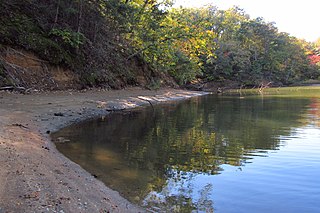Related Research Articles

The William Paca House is an 18th-century Georgian mansion in Annapolis, Maryland, United States. Founding Father William Paca was a signatory of the Declaration of Independence and a three-term Governor of Maryland. The house was built between 1763 and 1765 and its architecture was largely designed by Paca himself. The 2-acre (8,100 m2) walled garden, which includes a two-story summer house, has been restored to its original state.

The Brice House is, along with the Hammond-Harwood House and the William Paca House, one of three similar preserved 18th century Georgian style brick houses in Annapolis, Maryland. Like the Paca and Hammond-Harwood houses, it is a five-part brick mansion with a large central block and flanking pavilions with connecting hyphens. Of the three, the Brice House's exterior is the most austere, giving its brickwork particular prominence. The Brice House was declared a National Historic Landmark in 1970.

The National Archives Site is an archeological site at the National Archives facility in College Park, Prince George's County, Maryland. The site contains archeological remains from prehistoric settlements during the Late Archaic period, c. 4000-1500 B.C. Stone artifacts recovered through archeological testing indicate that this camp served as a place of stone tool manufacture and probably as a staging point for hunting and foraging. Physical integrity of the prehistoric component is high, with little plow disturbance or admixture with artifacts from other periods. The presence of a small number of other artifacts, including the projectile points, a spokeshave, and utilized flakes, indicates that the site also served in other hunting and foraging pursuits. It is one of a relatively small percentage of known prehistoric properties in Maryland with undisturbed archeological deposits.
Nottingham is a small town on the Patuxent River in Prince George's County, Maryland, United States. It contains an archaeological site which was listed on the National Register of Historic Places in 1975.

The Savage Mill Historic District is a national historic district located at Savage, Howard County, Maryland. The district comprises the industrial complex of Savage Mill and the village of workers' housing to the north of the complex.
Aisquith Farm E Archeological Site is an archaeological site near Riva in Anne Arundel County, Maryland. It is one of several small sites located within the confines of Aisquith farm. It is associated with the Early and Middle Woodland periods of cultural development in Anne Arundel County. The site is significant as a base camp property type.
Arundel Cove Archaeological Site is an archaeological site near Baltimore in Anne Arundel County, Maryland. It is situated on the south shore of Arundel Cove, a tributary of Curtis Creek which drains into the Patapsco River. The site was discovered during routine shovel test pitting of the U.S. Coast Guard Yard at Curtis Bay in 1981. The test pits revealed that the site is small in size, extending only 20 feet north–south by 15 feet east–west. It represents the remains of a prehistoric summer camp which apparently was not repeatedly occupied. It contains a prehistoric period storage pits, with evidence of the use of galium and wild black cherry.
The Beck Northeast Site is an archaeological site near Davidsonville in Anne Arundel County, Maryland. This site was discovered in the 1930s and investigations since that time have revealed artifacts dating from the Late Archaic period through the Middle Woodland period.
The Magothy Quartzite Quarry Archeological Site is an archaeological site near Pasadena in Anne Arundel County, Maryland. The site consists of several large outcroppings of quartzite and sandstone, that may have been utilized by prehistoric Native American groups as early as the Middle Archaic period, if not earlier.

The Martins Pond Archeological Site is an archaeological site near Annapolis in Anne Arundel County, Maryland. It is a Middle-Late Woodland period site, with lithic, floral, and faunal remains.
The Old Colony Cove Site is an archaeological site near Rose Haven in Anne Arundel County, Maryland. The site consists of a shell midden and is 2,000 feet (610 m) long by 300 feet (91 m) wide.
The Elkridge Site, or Elkridge Prehistoric Village Archeological Site, is an archaeological site near Elkridge in Anne Arundel County, Maryland. It is located on a 20-foot (6.1 m) terrace above the Patapsco River and extends 1,200 feet (370 m) along the river and inland from 20 to 400 feet. It is the only known Woodland period riverine-oriented village site in the tidewater Patapsco River valley which has at least partially escaped the totally destructive forces of gravel quarrying. The site appears to have been abandoned as a permanent village in the early 16th century.

Belvoir is a historic house at Crownsville, Anne Arundel County, Maryland. It is a two-story, T-shaped building, constructed of brick, stone, and wood. The home is a product of building evolution spanning the 18th, 19th, and 20th centuries. The earliest portion was probably built about 1736, but could date to the 17th century. It was the home of the grandmother of Francis Scott Key, who composed the Star Spangled Banner. Key visited in the summer in 1789.

Portland Manor is a historic home at Lothian, Anne Arundel County, Maryland, United States. It is a 2-story, center-passage plan, frame building. The main block was constructed in 1754, with the two wings added and enlarged about 1852. Also on the property are the remains of a large circular ice house and several frame outbuildings. Portland Manor was listed on the National Register of Historic Places in 1996.

Stanton Center is a historic building at Annapolis, Anne Arundel County, Maryland, United States. It is a two-story, Classical Revival brick masonry building with a one-story addition. It is the second school building on the site and was first used as an elementary school and later became the first high school for African Americans in Anne Arundel County. It remained in use as a school until the desegregation of the Anne Arundel County school system in the 1960s, when it became a community center.

Davidsonville Historic District is a national historic district at Davidsonville, Anne Arundel County, Maryland. It is located around a rural crossroads at the intersection of Central Avenue and Davidsonville Road. The district consists of fifteen properties: three churches, one commercial building, and eleven houses. They represent the period from the village's initial settlement in about 1835 through the early 20th century.
The Shawnee Old Fields Village Site, is an archaeological site near Oldtown in Allegany County, Maryland. The site contains Late Woodland and Contact period artifacts. An area between the site and the river's edge may be the location of a number of short-term camps and/or dwelling units. The first confirmed archeological manifestation of the several historically documented Shawnee villages in Maryland. It is believed to have been the home of Chief Opessa Straight Tail, a Shawnee leader.
Willin Village Archeological Site is an archaeological site near Eldorado in Dorchester County, Maryland. The Sussex Society of Archeology and History extensively excavated this site between 1951 and 1953. They identified grooved axes and stemmed points indicating use by Archaic peoples. It was possibly the site of a village during the Late Woodland period.
The Grear Prehistoric Village Site is an archeological site located near Crystal Beach, Cecil County, Maryland. The site was discovered and tested by an amateur archeologist in 1971. It is the northernmost known Late Woodland period village site on the Eastern Shore of the Chesapeake Bay outside of the Susquehanna River Basin.
Skipworth's Addition is an archeological site located near Harwood, Anne Arundel County, Maryland. It was identified in 1990 when the owners of the property unearthed several large pieces of North Devon pottery. Later excavation produced 17th-century artifacts, including glass, tobacco pipes, nails, refined earthenwares, and coarse ceramics, which confirm this site to be that of Skipworth's Addition. The site is located within the bounds of the 1664 patent "The Addition," which was issued in December 1662 to George Skipworth for an 18-acre (73,000 m2) tract. The Skipwiths were active members of the Quaker community and hosted a half-year Meeting for Men in their home at Skipworth's Addition in 1680.
References
- 1 2 "National Register Information System". National Register of Historic Places . National Park Service. April 15, 2008.
- ↑ "Katcef Archeological Site". Maryland Historical Trust. Retrieved October 29, 2008.


